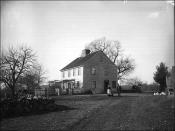Survival and Hysteria in "The Crucible":
Hysteria tears apart the community.
Hysteria replaces common sense and allows the people to believe that their neighbors, whom they have always considered respectable people, are committing illogical and unbelievable crimes-- communicating with the devil, killing babies, and more.
In "The Crucible", the townsfolk accept and become active in the hysterical atmosphere not only out of true religious devoutness (God doesn't allow interacting with the devil) but also because it gives them a chance to express kept feelings and to act on long-held grudges, claim other's land, and settle old scores.
The most obvious case is Abigail, who accuses Elizabeth Proctor of witchcraft and have her sent to jail.
Reverend Parris strengthens his position within the village, although temporarily, by making Proctor take the blame because he questions Parris' authority.
The rich Thomas Putnam gains revenge on Francis Nurse by getting Rebecca convicted of the witchery murders of Ann Putnam's 7 babies.
Thesis: In Arthur Miller's The Crucible, most residents of Salem act by following the majority, as the only option to survive, and joining the hysteria that is created by jealous, greedy, and illogical young girls.
Quotes:
1. "There is a misty plot afoot so subtle we should be criminal to cling to old respects and ancient friendships." Act II (page 71)
Reverend Hale to Francis Nurse defending the witch trials in the face of the outrageous arrest of Rebecca Nurse. The court has taken the witch trials a little too far and accusing extremely innocent people and he is telling him that the people that they were once so able to trust, are completely against them.
2. "Let you not mistake your duty as I mistook my own. I came into this village like a bridegroom to...


